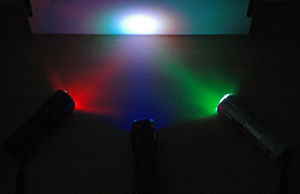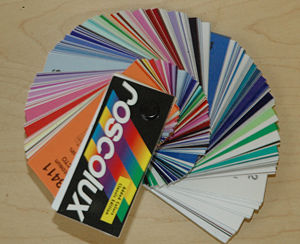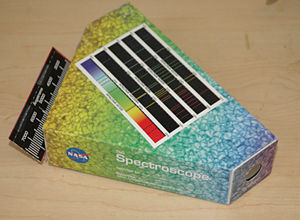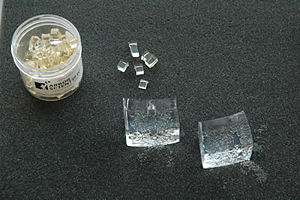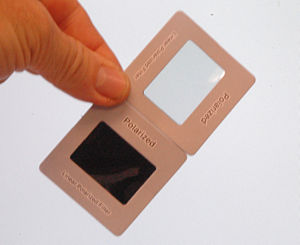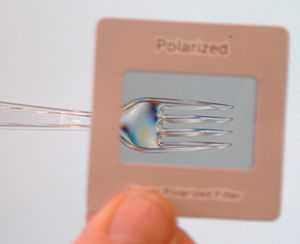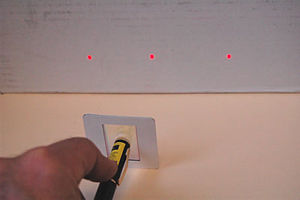Basic Optics - Outreach Kit
| Previous Topic | K-12 Outreach Kits | Next Topic |
Overview
Materials in the kit
- Color filters
- Nasa Spectroscope
- LED Flashlights with color filters
- Laser educational kit (laserpointer with lenses, filters, mirrors, diffraction grating)
- Grow Lens Cubes
- Test tubes
- Powdered milk
- Polarizing filters
- Nylon rope
User Guide
Key Concepts and Demos
1) White light is composed of many colors. Pass around the diffraction grating. Have them describe what they see. Are the colors the same for any light you look at? The diffraction grating is able to split light into in its colors. Connect to rainbows or prisms.
2) When red, green and blue are added together they produce white. Pass out the color flashlights. These produce red, green and blue light. What happens when two or more colors of light are combined.
- An RGB monitor has tiny red, green and blue dots. All colors including black can be made by mixing these three colors.
3) Light can be absorbed. Ask students what they know about color. Pass out colored filter samples and have students look at the colored light. Which color filter makes the light of a certain color go away? Colored filters absorb different colors and let other colors through. Ask which color paints are mixed together to make other colors. Is it possible to make white paint by mixing colored paints? No this is because each color absorbs another part of the spectrum. If you added enough colors together eventually to would absorb all the light making black. Have student pick three colors from the sample pack that when combined makes black or gray.
- Solar panels are black because they absorb many colors. We are trying to design new materials that can capture solar energy and convert the energy to electricity. We could make a blue solar cell. It would be pretty but what would be wrong with that.
4) The color of light can be described by wavelength. Point the spectroscope at a fluorescent light. Notice the green line that appears at the 5450 mark. You may not notice it but every light has its own unique color. Fluorescent bulbs are little bit green. Some street lights are blue or even orange. This color depends on the chemistry of the materials used in the bulb. Now place a color filter #89 that transmits color in the green part of the spectrum. Notice that the red line disappears from the fluorescent spectrum.
- LED s have distinct colors. Scientists and engineers are working to make LEDs that have light with the full spectrum of sunlight so colors look right. Other applications require LEDs with a very specific wavelength to match the material they must pass through such as plastic screens or fiber optics.
- We use instruments like the spectroscope to measure the light absorbed by chemicals we produce and to measure the light the color produce when they stimulated with lasers and electricity.
5) Light goes in a straight line until it interacts with matter. Use the laser show that light is very straight. Laser light is used to guide rockets, in surveying or carpentry to line things up, or even to guide farm machinery. Place the laser along a flat surface such as the floor or table and show that it is not affected by gravity. Fill the plastic tub with water and add some milk or powdered milk powder to make the light beam visible.
6) Light can be reflected. First ask what kinds of objects reflect light. Test the theories about what will reflect by pointing the laser at the objects that are suggested. They should be able to describe the quality of shiny, glassy or metallic being needed for mirrors. Place a mirror on the block which is attached to a protractor. Place the cylinder lens end tip on the laser so that it produces flat line instead of a dot. Orient the line so it is vertical (with the cylindrical lens horizontal). This will make it easier to see the light ray and its reflection on the table. Use the protractor to measure the angle of light coming in (angle of incidence) and the reflection angle of reflection. What rule can they make up for this. Challenge: what arrangement of mirrors would be needed to reflect a laser beam into a complete circle?
- We do many experiments with lasers that pass through many lenses, filters and sensors on a special optics table. We move the laser beam around the table using mirrors.
- Optical fiber has smooth surfaces and narrow diameter. Light reflects inside the tube until it shoots out end. This is called total internal reflection.
7) Light can be refracted. A day before the demonstration place several of the optic grow cubes into water in a plastic bag. Each cube will grow to about 5cm, optically clear cube. Use the laser pointer with preformed lenses and cut-able gel cubes or clear gelatin to show how lenses and prisms work. Try making a convex lens, a concave lens, an equilateral prism, a fiber optic tube, a periscope with right angle prisms.
- We use lenses to focus light to a point for experiments, or to make a wide parallel beam.
8) Light waves can be random or organized in one direction (coherent). Polarized materials only allow light with a certain orientation to pass through. Have two students hold the nylon rope and generate a wave in the crossways direction. Place two straight back chairs back to back on either side of the rope so that it’s horizontal movement is limited. The waves will be dampened. Ask the students to generate a wave in the up and down direction. This will pass through between the chairs. This how a polarized light is blocked or passé through a polarizing filter. Use the polarizing filters to show that light from a laser or from an LCD monitor can be almost completely blocked as the filter is rotated.
Two filters can be used to block non polarized light. Clear materials such as plastics can change the polarity of light when they are under stress because their molecules get aligned in a certain way. If you place a clear plastic spoon between two polarizing filters or between an LCD monitor (a polarized light source) and a polarizing filter you can see rainbow colored patches where light is being blocked or refracted in response to stresses in the material.
- Liquid crystal displays have a polarized light source. The liquid crystal chemicals can be rearranged when electricity is applied to change the way they polarize light and thus let certain light pass through under the red, green and blue cells. This property can be used to control light in fiber networks and computers.
- CMDITR is created new organic materials that can change their polarization in an electric field or when light of specific wavelength is provided.
9) Lasers light is coherent and a precise wavelength. Place a diffraction grating in front of the laser pointer. There will be three dots, one for straight transmission and two diffracted dots on either side. Compare this to the pattern that appears from looking at a fluorescent bulb with a diffraction grating.
10) Advanced- See experiments 6, 7, 8 of the laser
Links
OSA classroom materials including the Optics Suitcase
Innovative Methods to Teach Optics in the Grade 5- (including jello optics)
Hands On Optics from OSA, SPIE and NOAO
Sources for Building your own kit
- http://www.i-fiberoptics.com/laser-kits-projects-detail.php?id=2240 $51 Laser pointer education kit class II red laser pointer
- http://www.arborsci.com/detail.aspx?ID=1428 grow lens cubes (100s) $8 (clear gel to play with lens shapes)
- http://scientificsonline.com/product.asp_Q_pn_E_3053471 Acrylic prisms set $34
- Color filter pack $24
- Individual filter samples 2 x $1.99
- White flashlights 3 x $8
- http://www.arborsci.com/detail.aspx?ID=380 Fog in a can $16.95
- http://www.arborsci.com/detail.aspx?ID=395 slide mounted polarizing filters( 50) $33
- http://www.arborsci.com/detail.aspx?ID=37 6 gel color filter pack $12

